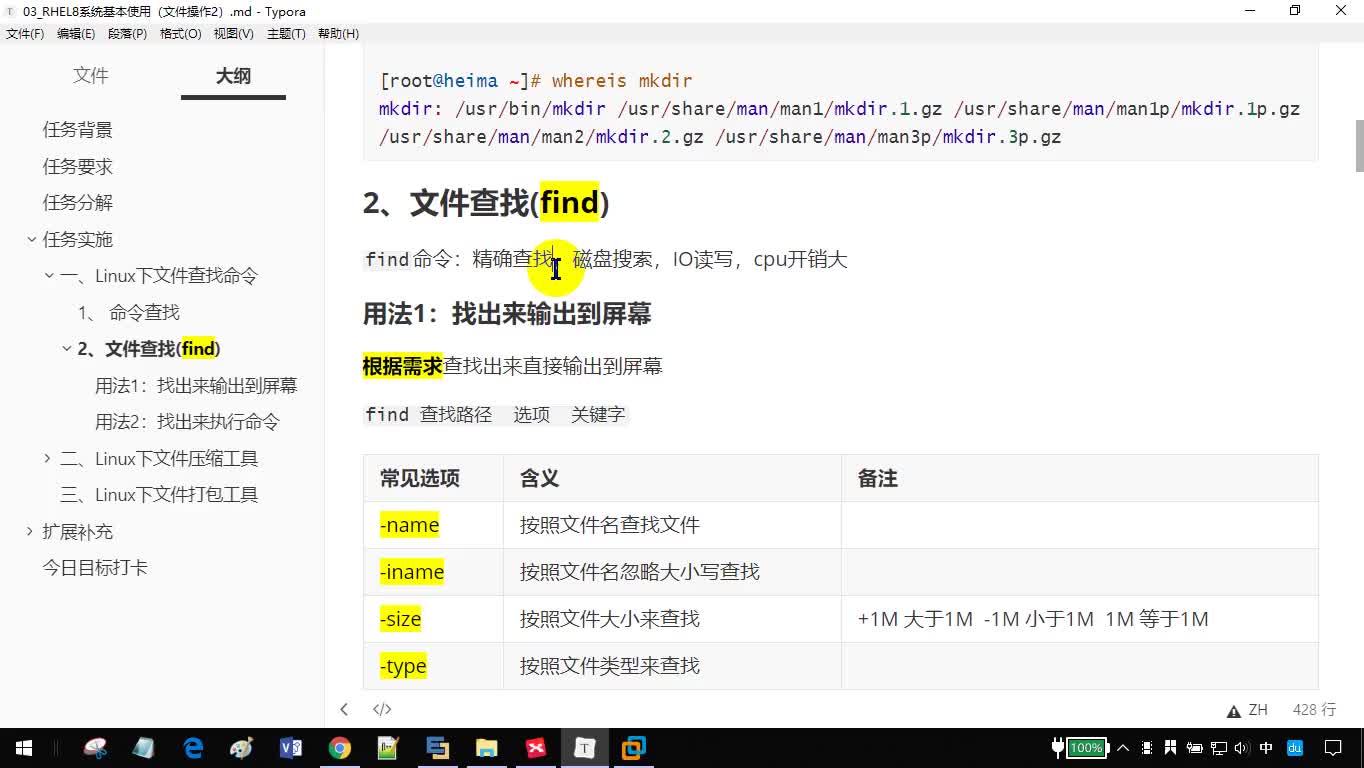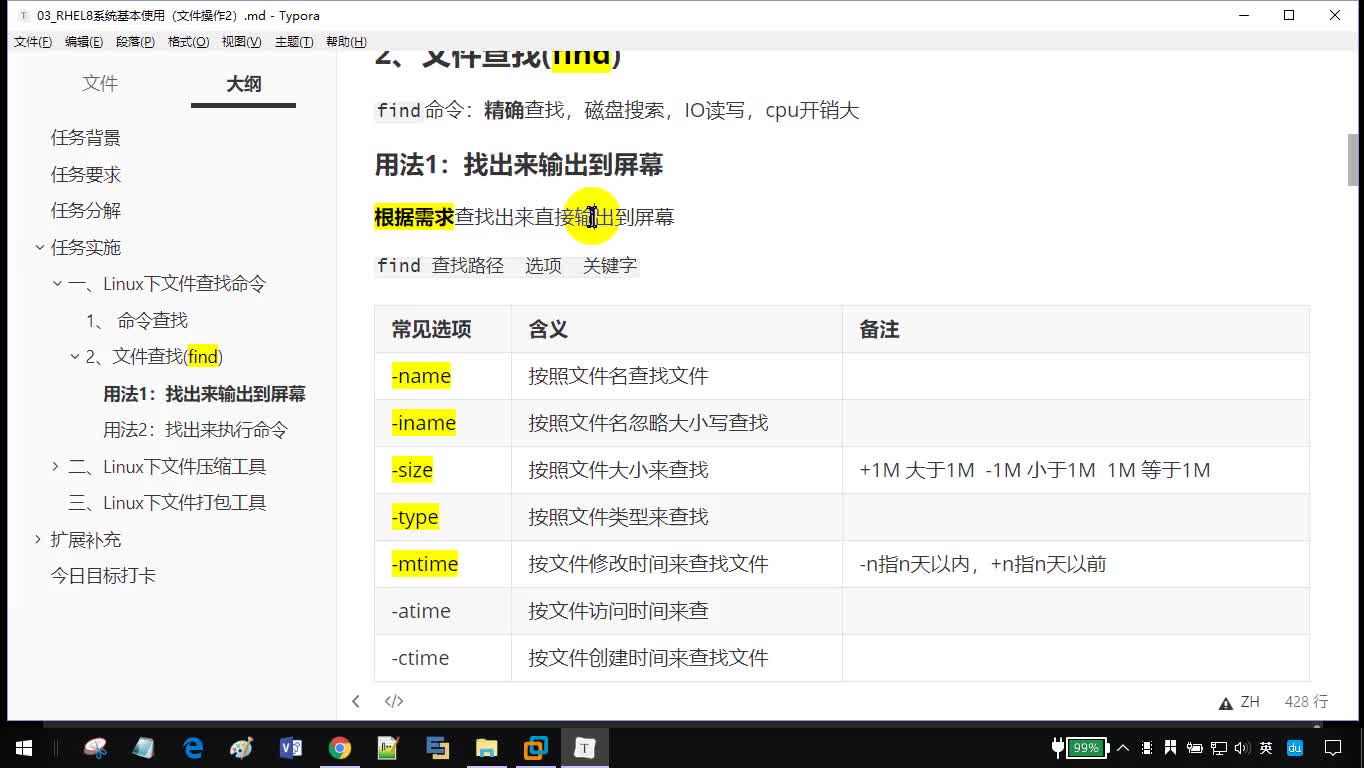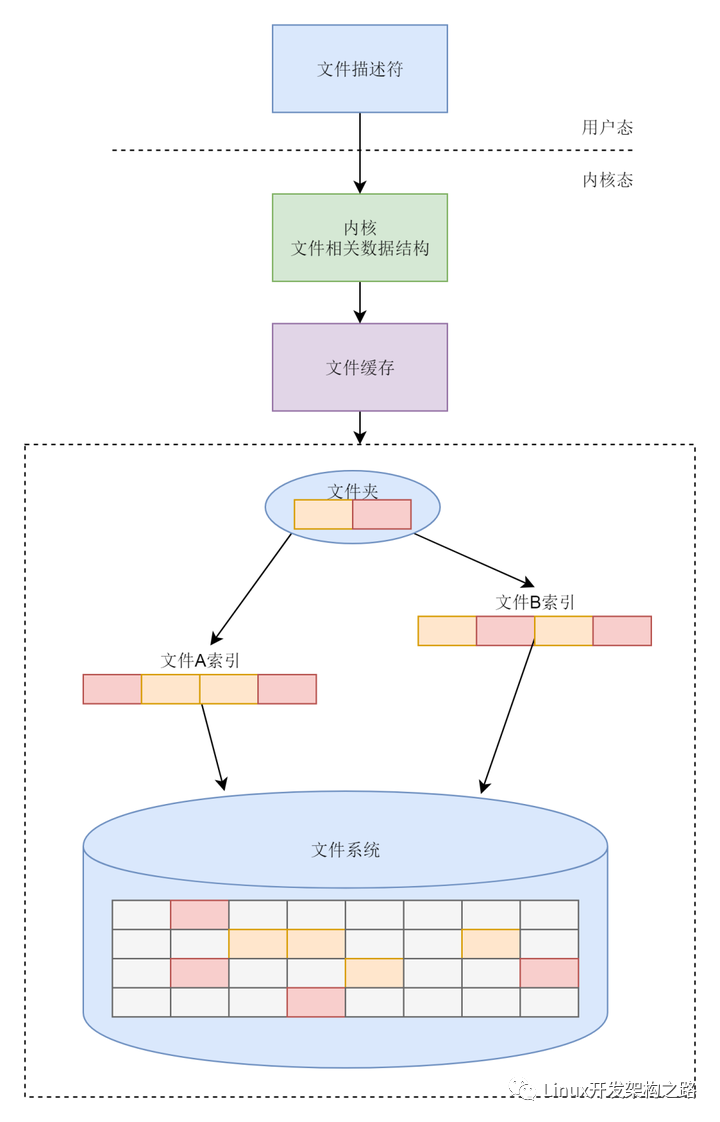Linux文件查找
1.find查找概述
为什么要有文件查找,因为很多时候我们可能会忘了某个文件所在的位置,此时就需要通过find来查找。
find命令可以根据不同的条件来进行查找文件,例如:文件名称、文件大小、文件修改时间、属主属组、权限、等等方式。同时find命令是Linux下必须掌握的。
*find 命令的基本语法如下*
| 命令 | 路径 | 选项 | 表达式 | 动作 |
|---|---|---|---|---|
| find | [path…] | [options] | [expression] | [action] |
| 查找 | 地区 | 妹纸 | 18-25岁 | 约? |
是linux里面的一个实时查找工具,通过制定路径完成文件查找
find [options] ..... [查找路径] [查找条件] [处理动作]
查找路径:查找的位置,默认是当前文件夹
查找条件:制定查找的标准,文件名、大小、类型、日期等等
处理动作:对符合条件的文件做什么操作,默认是输出到屏幕上
2.find查找示例
*以下列出所有find常用的选项*
1.find名称查找
#1.创建文件
touch /etc/sysconfig/network-scripts/{ifcfg-eth1,IFCFG-ETH1}
#2.查找/etc目录下包含ifcfg-eth0名称的文件
[root@lqz ~]# find /etc -name "ifcfg-eth1"
#3.-i 忽略大小写
[root@lqz ~]# find /etc -iname "ifcfg-eth1"
#查找/etc目录下包含ifcfg-eth名称所有文件
[root@lqz ~]# find /etc/ -name "ifcfg-eth*"
[root@lqz ~]# find /etc -iname "ifcfg-eth*"
2.find大小查找
#1.查找大于5M的文件 [root@lqz ~]# find /etc -size +5M #2.查找等于5M的文件 [root@lqz ~]# find /etc -size 5M #3.查找小于5M的文件 [root@lqz ~]# find /etc -size -5M
3.find类型查找
# f 文件 [root@lqz ~]# find /dev -type f # d 目录 [root@lqz ~]# find /dev -type d # l 链接 [root@lqz ~]# find /dev -type l # b 块设备 [root@lqz ~]# find /dev -type b # c 字符设备 [root@lqz ~]# find /dev -type c # s 套接字 [root@lqz ~]# find /dev -type s # p 管道文件 [root@lqz ~]# find /dev -type p
4.find时间查找
#1.创建测试文件(后期shell会讲)
[root@lqz ~]# for i in {01..28};do date -s 201904$i && touch file-$i;done
#2.查找7天以前的文件(不会打印当天的文件)
[root@lqz ~]# find ./ -iname "file-*" -mtime +7
#3.查找最近7天的文件,不建议使用(会打印当天的文件)
[root@lqz ~]# find ./ -iname "file-*" -mtime -7
#4.查找第7天文件(不会打印当天的文件)
[root@lqz ~]# find ./ -iname "file-*" -mtime 7
#5.本地文件保留最近7天的备份文件, 备份服务器保留3个月的备份文件(实际使用方案)
find /backup/ -iname "*.bak" -mtime +7 -delete
find /backup/ -iname "*.bak" -mtime +90 -delete
5.find用户查找
#查找属主是jack [root@lqz ~]# find /home -user jack #查找属组是admin [root@lqz ~]# find /home -group admin #查找属主是jack, 属组是admin [root@lqz ~]# find /home -user jack -group admin #查找属主是jack, 并且属组是admin [root@lqz ~]# find /home -user jack -a -group admin #查找属主是jack, 或者属组是admin [root@lqz ~]# find /home -user jack -o -group admin #查找没有属主 [root@lqz ~]# find /home -nouser #查找没有属组 [root@lqz ~]# find /home -nogroup #查找没有属主或属组 [root@lqz ~]# find /home -nouser -o -nogroup
6.find权限查找
#精切匹配644权限 [root@lqz ~]# find . -perm 644 -ls #包含444权限即可 [root@lqz ~]# find . -perm -444 -ls #查找全局可写(每位权限必须包含w) [root@lqz ~]# find . -perm -222 -ls #包含set uid [root@lqz ~]# find /usr/sbin -perm -4000 -ls #包含set gid [root@lqz ~]# find /usr/sbin -perm -2000 -ls #包含sticky [root@lqz ~]# find /usr/sbin -perm -1000 -ls
查找条件
根据文件名查找
-name 指定名称,可以使用正则
-iname 忽略大小写
-links n 引用次数为n的文件
-regex 后面跟完整路径,而不是文件名, 必须整个路径完全匹配
制定搜索的层级
-maxdepth level 最大的搜索深度,指定的目录为第1层
-mindepth level 最小的搜索深度,包括level层
根据属主、属组来查找
-user username 查找属主为username的文件
-group groupname 查找属组为groupname的文件
-uid id 查找属主为id的文件
-gid id 查找属组为id的文件
-nouser 查找没有属主的文件
-nogroup 查找没有属组的文件
m[root@192 test]#chown qiao b m[root@192 test]#ll total 0 drwxr-xr-x. 4 root root 24 Dec 4 22:50 a -rw-r--r--. 1 qiao root 0 Dec 6 17:53 b m[root@192 test]#chown :llx b m[root@192 test]#ll total 0 drwxr-xr-x. 4 root root 24 Dec 4 22:50 a -rw-r--r--. 1 qiao llx 0 Dec 6 17:53 b m[root@192 test]#find -group llx ./b m[root@192 test]#id root uid=0(root) gid=0(root) groups=0(root) m[root@192 test]#id qiao uid=1000(qiao) gid=1000(qiao) groups=1000(qiao) m[root@192 test]#find -uid 1000 ./b m[root@192 test]#useradd xiaobao m[root@192 test]#chown xiaobao b m[root@192 test]#ll total 0 drwxr-xr-x. 4 root root 24 Dec 4 22:50 a -rw-r--r--. 1 xiaobao llx 0 Dec 6 17:53 b m[root@192 test]#userdel xiaobao m[root@192 test]#ll total 0 drwxr-xr-x. 4 root root 24 Dec 4 22:50 a -rw-r--r--. 1 1002 llx 0 Dec 6 17:53 b m[root@192 test]#find -nouser ./b # 全盘找 m[root@192 test]#find / -nouser
根据文件类型 -type
d 目录
f 文件
l 符号链接
s 套接字
b 块设备
c 字符设备
p 管道文件
m[root@192 test]#find -type f ./b
空文件或者空目录
-empty
m[root@192 test]#find -empty
条件
与 -a
或 -o
非 -not
m[root@192 test]#find -empty -o -type d m[root@192 test]#find -empty -not -type d ./b
摩根定律
非(A或者B) 非A 且非B
非(A且B)非A或非B
m[root@192 ~]#find !(-empty -a -tpye d)
排除目录
-path
[root@localhost test]#find /etc -name *_config /etc/ssh/ssh_config /etc/ssh/sshd_config [root@localhost test]#find /etc -path /etc/ssh -name *_config
按照大小来查找
-size # (#-1,#] 不包括#-1,包括#
-size -# [0,#-1] 包括#-1
-size +# (#,......)
按照时间来查找
-amin
-mmin
-cmin
-atime # [#,#+1)
-atime -# (0,#)
-atime +# [#+1,....]
查找7天以后的文件 find -atime +7
-mtime
-ctime
以分钟为单位
3 处理动作
find动作处理,比如查找到一个文件后,需要对文件进行如何处理, find的默认动作是 -print
1.find查找后的动作命令示例
| 动作 | 含义 |
|---|---|
| 打印查找到的内容(默认) | |
| -ls | 以长格式显示的方式打印查找到的内容 |
| -delete | 删除查找到的文件(仅能删除空目录) |
| -ok | 后面跟自定义 shell 命令(会提示是否操作) |
| -exec | 后面跟自定义 shell 命令(标准写法 -exec |
- -print 默认的处理动作,显示在屏幕上
- -ls 类似于ls -l 显示长格式
- -delete 删除查找到的文件
- -fls file 将查找的结果以长格式保存到文件中
- -ok command {} ; 对每一个查找到的文件执行command命令,在执行命令之前要先提示用户是否要执行
find -size 2M -ok rm -rf {} ; 找到2M的文件,删除,提示删除
-exec command {} ; 对查到的每一个文件执行command命令,不需要确认,一次性交给后面命令处理
find -size 2M -exec rm -rf {} ;
m[root@192 test]#find -size 2M -delete
#1.使用-print打印查找到的文件
[root@lqz ~]# find /etc -name "ifcfg*"
[root@lqz ~]# find /etc -name "ifcfg*" -print
#2.使用-ls打印查找到的文件,以长格式显示
[root@lqz ~]# find /etc -name "ifcfg*" -ls
#3.使用-delete删除文件,但仅能删除空目录
[root@lqz ~]# find /etc -name "ifcfg*" -delete
#4.使用-ok实现文件拷贝,但会提示是否拷贝
[root@lqz ~]# find /etc -name "ifcfg*" -ok cp -rvf {} /tmp ;
#5.使用-exec实现文件拷贝和文件删除。
[root@lqz ~]# find /etc -name "ifcfg*" -exec cp -rvf {} /tmp ;
[root@lqz ~]# find /etc -name "ifcfg*" -exec rm -f {} ;
2.使用find命令结合xargs
有的命令不支持管道
命令参数过长
xargs 将管道前面的内容一条一条的交给后面命令处理
echo file{1..50000}|xargs touch
一般会跟find使用
#xargs将前者命令查找到的文件作为一个整体传递后者命令的输入
[root@lqz ~]# touch file.txt
[root@lqz ~]# find . -name "file.txt" |xargs rm -f
[root@lqz ~]# find . -name "file.txt" |xargs -I {} cp -rvf {} /var/tmp
3.find逻辑运算符
| 符号 | 作用 |
|---|---|
| -a | 与 |
| -o | 或 |
| -not|! | 非 |
#1.查找当前目录下,属主不是hdfs的所有文件
[root@lqz ~]# find . -not -user hdfs
[root@lqz ~]# find . ! -user hdfs
#2.查找当前目录下,属主属于hdfs,且大小大于300字节的文件
[root@lqz ~]# find . -type f -a -user hdfs -a -size +300c
#3.查找当前目录下的属主为hdfs或者以xml结尾的普通文件
[root@lqz ~]# find . -type f -a ( -user hdfs -o -name '*.xml' )
4.find相关练习题
1.查找/tmp目录下,属主不是root,且文件名不以f开头的文件
2.查找/var目录下属主为root,且属组为mail的所有文件
3.查找/var目录下不属于root、lp、gdm的所有文件
4.查找/var目录下最近一周内其内容修改过,同时属主不为root,也不是postfix的文件
5.查找/etc目录下大于1M且类型为普通文件的所有文件
6.将/etc/中的所有目录(仅目录)复制到/tmp下,目录结构不变
7.将/etc目录复制到/var/tmp/,/var/tmp/etc的所有目录权限777/var/tmp/etc目录中所有文件权限666
8.保留/var/log/下最近7天的日志文件,其他全部删除
9.创建touch file{1..10}10个文件, 保留file9,其他一次全部删除
10.解释如下每条命令含义
mkdir /root/dir1
touch /root/dir1/file{1..10}
find /root/dir1 -type f -name "file5"
find /root/dir1 ! -name "file5"
find /root/dir1 -name "file5" -o -name "file9"
find /root/dir1 -name "file5" -o -name "file9" -ls
find /root/dir1 ( -name "file5" -o -name "file9" ) -ls
find /root/dir1 ( -name "file5" -o -name "file9" ) -exec rm -rvf {} ;
find /root/dir1 ! ( -name "file4" -o -name "file8" ) -exec rm -vf {} ;
linux三剑客
三剑客详解
grep
awk
sed
grep
grep [option] "模式" file
option
--color=auto 对匹配到的行添加颜色 -v 取反 -i 不区分大小写 -n 查找的内容增加行号 -c 打印匹配到的行数 -o 只显示匹配到的文字 -q 静默模式 -A # after 向下显示#行 -B # before 向上显示#行 —C # context 上下分别显示#行 -e 或者 grep -e 'user' -e 'root' passwd 或的意思 -E 扩展正则表达式 -F 不使用正则表达式 -r 递归 -w 匹配整个单词
正则表达式元字符
字符匹配
. 任意单个字符
[] 匹配指定范围内的任意单个字符 [0-9] [a-z] [A-Z]
[^] 取反
[] 大写字母
[] 小写字母
[] 字母和数字
[] 大小写字母
[] 数字
m[root@192 test]#grep '[[]]+' c
# 匹配数字
[:black:] 空白
[:punct:] 标点符号
匹配次数
* 表示任意次数
.* 任意字符任意次数
? 表示0或者1次
+ 至少一次
{n} 表示n次 转义字符
{m,n} 最少m次,最多n次
{n,} 至少n次
{,n} 至多n次
位置锚定
^ 开头
$结尾
^$ 空行
grep -v "^#" /etc/ssh/sshd_config |grep -v "^$" 显示不以#开头并且不是空行
分组
grep "(c|C)at" a
向后引用
1 前面第一个括号出现的内容匹配完成之后再后面在出现一次
2 前面第二个括号出现的内容匹配完成之后再后面在出现一次
grep "(l..e).*1" c love djfdjfd;d love
扩展正则表达式
与正则表达式的区别是不需要转义
grep -E "(c|C)at" a
不需要加进行转义
-
Linux
+关注
关注
87文章
11383浏览量
211576 -
Find
+关注
关注
0文章
55浏览量
11727
原文标题:正则表达式元字符
文章出处:【微信号:magedu-Linux,微信公众号:马哥Linux运维】欢迎添加关注!文章转载请注明出处。
发布评论请先 登录
相关推荐


linux中怎么用find查找文件
Linux文件查找命令find,xargs详述
Linux文件管理命令语法、参数、实例全汇总

如何在Linux使用wc命令统计目录文件
如何在Linux中查找断开的符号链接
Python如何快速查找文件
如何使用命令行在Linux中查找文件?
如何在Linux中查找文件所有者?

linux中查找文件的命令
Linux文件查找神器对决:Locate与find选谁





 Linux文件查找
Linux文件查找













评论